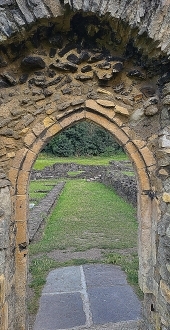An abbey at one end of London’s Elizabeth Line railway
ONE BRANCH OF London’s recently opened Elizabeth Line terminates at Abbey Wood, which is in the southeastern Borough of Bexley. A few minutes’ walk away from the station brings one to a large park called Abbey Wood, which I visited for the first time yesterday, the 24th of July 2024. The park contains the ruins of a 12th century Augustinian abbey – Lesnes Abbey.

The abbey was founded in 1178 by Richard de Luci (1089-1179), Lord of the Manor of Lesnes and Chief Justiciar of England (something analogous to a modern ‘Prime Minister’). It is believed that he founded the abbey as a repentance for his sins and also for those related to the murder of Thomas a Becket in Canterbury cathedral in 1174. Unfortunately, Lesnes never became established as one of Engand’s greater monastic institutions. This might have been due to the large amounts of money it had to expend on draining its pastures, which were regularly flooded by the waters of the nearby River Thames. In addition, the abbey developed a bad reputation because of its members disorderliness, which included many instances of immoral behaviour. Despite help from outside sources, the abbey continued to decline until it was dissolved (in 1525), along with many other religious establishments, by King Henry VIII.
After it was closed, the land and remains of the Abbey passed through various hands until it was bequeathed to Christ’s Hospital School in 1688. Between that date and 1933, the land was used as a farm by the school. From 1909 to 1913, the Woolwich and District Antiquarian Society carried out extensive archaeological investigations of the site of the abbey. One of their many discoveries was a stone effigy of a knight, who could be identified as being part of the de Luci family. It is now stored in the Victoria and Albert Museum in South Kensington. From 1939 to 1954, the new owners of the land, the London County Council, carried out further excavations. After that, in 1956, the ruins were made safe for visitors, and these can be viewed today. In 1986, the park and the ruins were transferred to the care of Bexley Borough Council, who have made the place very ‘user-friendly’ with excellent paths, helpful direction signs, information panels, and a lovely visitors’ centre with a small café.
The ruins are quite extensive and seen from a hillock above them, one can clearly see the ground plan of the abbey. Most of the ruins are low in stature, but a few walls of over 6 feet high are still standing. In what was once the abbey’s church, there are several carved pillar bases and other fragments of the original structure. Nothing apart from its ground plan remains of the cloisters, which were filled with picnickers and children when I visited. All in all, the ruins of Lesnes Abbey compare well with others I have seen during my travels in England and Wales. But they are not as spectacular as, say, Tintern Abbey in Wales and Fountains in Yorkshire. However, unlike the two mentioned, which take many hours to reach from London, Lesnes is a mere 26 minutes’ train ride from Bond Street.
I had not known of the existence of the ruins of Lesnes Abbey until a few days’ ago when I looked up mulberry trees on the Internet. One of the examples of mulberry trees that came up on the screen of my computer was that which is growing next to the ruins of Lesnes Abbey. According to the excellent guidebook to the abbey by Chris Hawkins, which I bought at the café, the mulberry at Lesnes was probably planted in around 1720. It was during this period that the monarch, hoping to establish an English silk industry, imported many mulberry trees to England. Unfortunately, the enterprise was doomed to failure because mulberry trees of the wrong variety were imported – the kind whose leaves were not suitable for feeding silkworms. The ancient mulberry tree at Lesnes is flourishing but has grown in such a way that its huge twisting trunk must be supported by steel struts.
I can strongly recommend a trip to Abbey Wood to view the ruined abbey. Having seen it, I am surprised that this fascinating site it is not better known outside the confines of southeast London.



